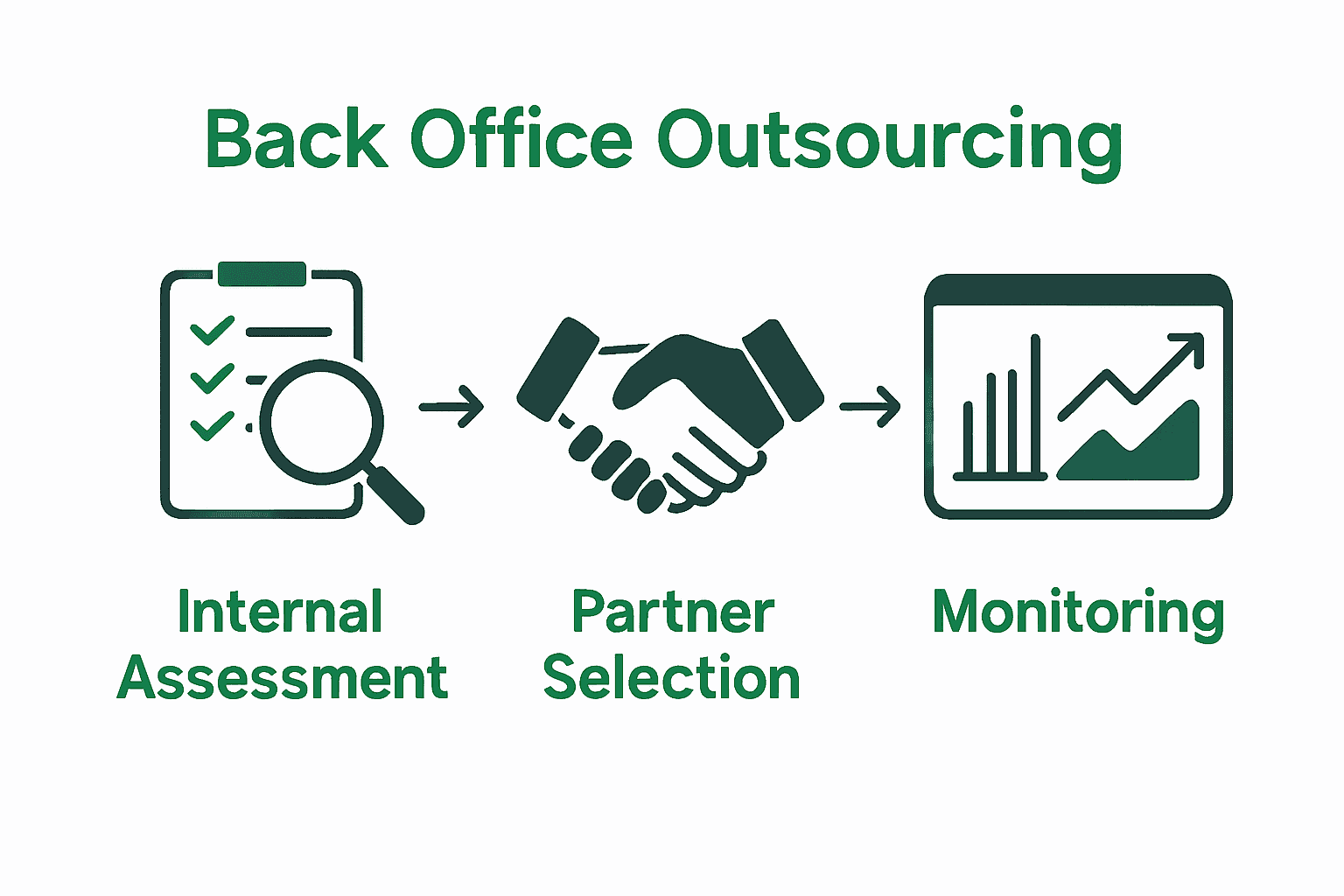Did you know that more than 60 percent of companies outsource at least one business process to boost productivity? Making smart outsourcing decisions begins with understanding your own operations and objectives. When you know which tasks really drain your resources, you can focus staff energy on areas that help your business grow. This guide walks you through the exact steps for creating an outsourcing strategy that sharpens efficiency and sets your business up for long-term success.
Step 1: Assess Internal Needs and Define Objectives
Before diving into outsourcing, you need a crystal clear picture of what your business actually needs. This means taking a comprehensive look at your current operations and identifying which tasks are consuming valuable time and resources without directly contributing to your core business goals. Think of this as performing an internal x-ray of your organization.
Start by mapping out all your current business processes and carefully evaluate which functions are critical to your strategic objectives versus those that are repetitive administrative tasks. Research shows organizations can dramatically improve efficiency by identifying non core functions suitable for external support. For instance, administrative tasks like data entry, customer support scheduling, or routine documentation often represent prime candidates for outsourcing. By strategically offloading these responsibilities, your team can redirect energy toward high impact strategic activities that genuinely drive business growth.
Pro tip: Create a detailed spreadsheet categorizing each business function based on three key criteria categories: strategic importance, complexity, and current internal resource allocation. This systematic approach will help you objectively determine which processes make the most sense to outsource. Your goal is not just reducing costs but enhancing overall operational effectiveness.

Once you complete this assessment, you will be ready to move forward with developing a targeted outsourcing strategy that aligns perfectly with your organizational objectives.
Step 2: Select and Evaluate Suitable Outsourcing Partners
Selecting the right outsourcing partner is like choosing a critical business teammate who will represent your company’s operational standards and efficiency. This step requires careful, strategic evaluation to ensure you find a partner who truly understands your business needs and can deliver exceptional results.
Your selection process should involve comprehensive research into potential providers. Look beyond surface level marketing and dig deep into their specialized skills, track record, and ability to provide scalable solutions. When evaluating potential partners, consider key factors such as their industry experience, technological capabilities, service offerings, and pricing structures. Research suggests businesses should prioritize providers who offer flexible staffing solutions and demonstrate expertise in the specific back office functions you want to outsource. Pay close attention to their communication processes, data security protocols, and case studies from companies similar to yours.
Pro tip: Create a detailed evaluation matrix that scores potential partners across multiple dimensions including technical competence, cultural alignment, cost effectiveness, scalability, and proven performance metrics.
Once you complete this thorough vetting process, you will have identified an outsourcing partner who can seamlessly integrate with your organizational goals and help drive operational efficiency. The next critical step involves establishing clear communication channels and defining precise performance expectations.
Step 3: Develop Clear Contracts and Communication Protocols
Now that you have selected a potential outsourcing partner, the next crucial step is creating ironclad agreements that set crystal clear expectations for both parties. Think of this as building the blueprint for your collaborative relationship a comprehensive roadmap that prevents misunderstandings and ensures smooth operational execution.
Establishing robust service level agreements is fundamental to successful outsourcing partnerships. Your contract should meticulously outline performance expectations including precise quality standards delivery timelines communication frequencies and specific metrics for measuring success. Research indicates that organizations with well defined service level agreements experience significantly smoother collaboration and reduced potential for conflicts. These agreements should comprehensively cover key areas like project scope performance benchmarks data security protocols payment terms response times and escalation procedures for potential issues. Beyond the technical details focus on creating a framework that promotes transparency accountability and mutual understanding.
Pro tip: Include specific clauses about data confidentiality communication channels reporting requirements and mechanisms for periodic performance reviews to maintain alignment and adaptability throughout your partnership.
By developing comprehensive and clear communication protocols you are setting the stage for a strategic partnership that can evolve and adapt to your changing business needs.
The next step involves implementing robust monitoring and performance tracking systems to ensure your outsourcing relationship continues to deliver the expected value and efficiency.
Step 4: Onboard Remote Teams and Integrate Workflows
Onboarding remote teams is like choreographing a complex dance where precision and smooth coordination are essential. Your goal in this step is to seamlessly integrate external teams into your existing operational ecosystem while maintaining productivity and minimizing disruption.
Develop a comprehensive transition plan that goes far beyond basic introductions. This involves creating detailed documentation that maps existing workflows knowledge transfer protocols and specific performance expectations. Research indicates that successful onboarding requires a structured approach focusing on clear communication technological integration and cultural alignment. Start by scheduling intensive initial training sessions where your internal team can directly share institutional knowledge operational nuances and specific workflow requirements. Consider implementing collaborative tools that enable real time communication screen sharing and collaborative document editing to bridge potential geographical and operational gaps. Ensure your remote team understands not just the technical requirements but also the underlying business objectives and cultural context of their assigned tasks.
Pro tip: Create a dedicated onboarding portal or shared digital workspace that provides remote teams with comprehensive resources including process documentation standard operating procedures video tutorials and direct communication channels with key internal stakeholders.
By investing significant effort in thoughtful onboarding you transform external resources into true strategic partners who understand your organizational DNA. The next phase involves establishing robust performance monitoring mechanisms to track progress and continuously optimize your outsourcing strategy.
Step 5: Monitor Performance and Optimize Back Office Processes
Monitoring the performance of your outsourced back office functions is not just about tracking metrics its about creating a dynamic feedback loop that continuously enhances operational efficiency. This step transforms your outsourcing relationship from a transactional arrangement into a strategic partnership of ongoing improvement.
Establish a comprehensive performance monitoring framework that goes beyond simple spreadsheets and superficial reporting. Research suggests implementing a multi tiered review process that includes weekly operational reports monthly performance summaries and quarterly strategic assessments. Your monitoring strategy should incorporate both quantitative metrics like task completion rates accuracy levels and response times as well as qualitative feedback from internal stakeholders. Gather input from different departments to understand how the outsourced team impacts overall organizational performance. Use advanced analytics and reporting tools to create transparent performance dashboards that provide real time insights into productivity efficiency and potential areas of optimization. Pay special attention to key performance indicators that directly align with your original outsourcing objectives and be prepared to make data driven adjustments.

Pro tip: Create a collaborative performance improvement mechanism where your internal team and outsourcing partner can jointly review metrics discuss challenges and develop innovative solutions for continuous enhancement.
By implementing a robust performance monitoring approach you transform outsourcing from a static service into a dynamic strategic asset that evolves with your business needs. The final phase involves maintaining flexibility and being open to iterative improvements based on ongoing performance insights.
Unlock Your Business Potential with Expert Back Office Outsourcing
Struggling to streamline your back office operations while maintaining quality and cost-efficiency is a challenge many growing businesses face. This article highlights essential steps like identifying non-core functions, selecting the right outsourcing partner, and monitoring performance to boost overall efficiency. If you want to move beyond just managing tasks and create a strategic partnership that drives growth, it is vital to leverage experienced professionals who understand these complexities.
At NineArchs LLC, we specialize in tailored remote workforce solutions designed to address these specific pain points. Our services span virtual assistance, business process outsourcing, and technology support that enable you to offload repetitive administrative work, protect data security, and maintain clear communication channels. Imagine having a partner who not only helps you outsource effectively but also integrates seamlessly with your workflows and adapts as your business evolves.
Explore Our Technology Services
Discover How Knowledge Outsourcing Transforms Business

Take control of your back office today and unlock true efficiency with NineArchs. Visit our website now to learn how our professional outsourcing and IT solutions can be customized to fit your business goals and reduce operational burdens immediately.
Frequently Asked Questions
What are the first steps to assess my internal needs for back office outsourcing?
Start by mapping out all your current business processes and identifying which tasks are time-consuming but not core to your strategic goals. Use a spreadsheet to categorize functions based on their strategic importance, complexity, and current resource allocation.
How can I choose the right outsourcing partner for my business?
Evaluate potential partners by researching their industry experience, technological capabilities, and flexibility in staffing solutions. Create a detailed evaluation matrix to score them on key dimensions such as cost-effectiveness and proven performance metrics.
What should I include in a service level agreement with my outsourcing partner?
A service level agreement (SLA) should outline performance expectations, quality standards, delivery timelines, and specific metrics for success. Include clauses for data confidentiality and communication protocols to ensure clarity and accountability throughout the partnership.
How can I effectively onboard remote teams into my existing workflows?
Develop a comprehensive onboarding plan that includes training sessions and detailed documentation of existing workflows. Utilize collaborative tools for real-time communication and provide resources in a shared digital workspace to help remote teams integrate smoothly.
What metrics should I monitor to ensure the efficiency of outsourced back office functions?
Establish a multi-tiered monitoring framework that includes quantitative metrics like task completion rates and qualitative feedback from internal stakeholders. Regularly review these metrics to identify areas for improvement and ensure the outsourcing partnership adds value to your operations.
How can I optimize back office processes after outsourcing?
Create a feedback loop that involves weekly and monthly performance reviews alongside quarterly strategic assessments. Collaborate with your outsourcing partner to discuss challenges and find innovative solutions, allowing you to adapt and enhance processes continuously.










[…] How to Outsource Back Office for Business Efficiency | NineArchs […]
[…] How to Outsource Back Office for Business Efficiency | NineArchs […]
[…] How to Outsource Back Office for Business Efficiency | NineArchs […]